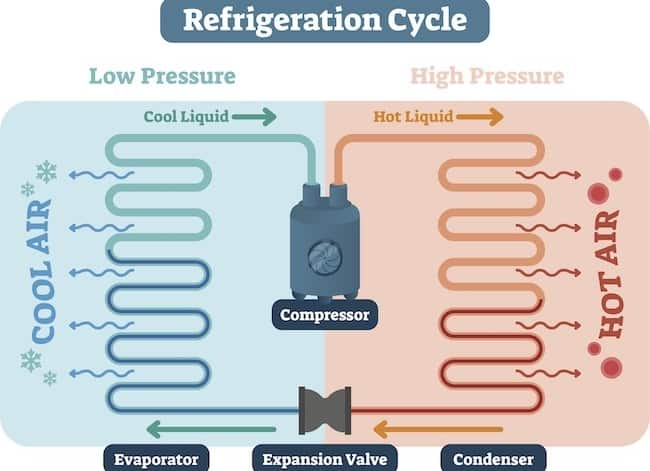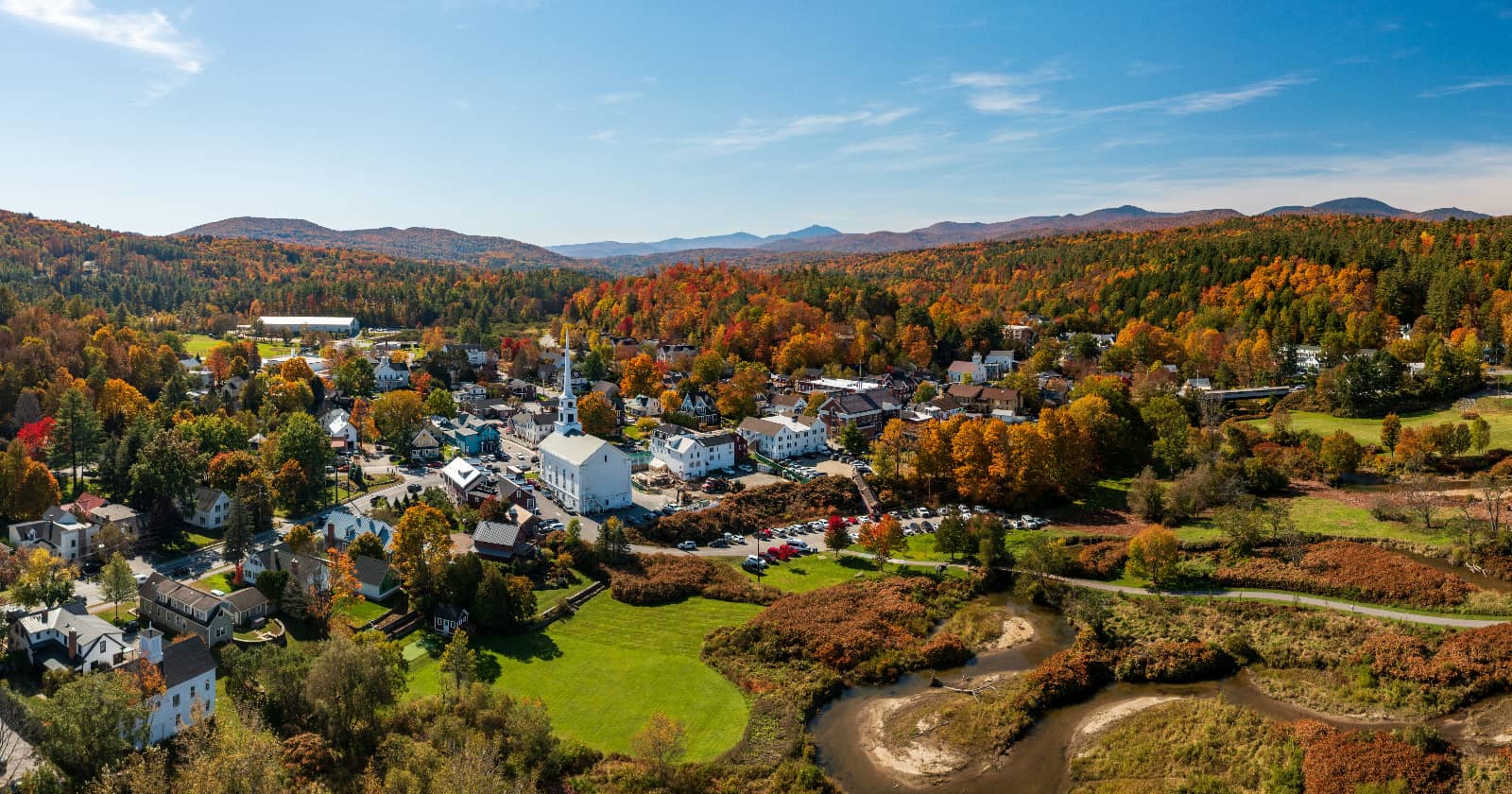Having a heat pump option on your RV is great for saving on propane heating costs, especially if you are staying short-term in an RV park and not paying extra for the electricity. You may have noticed that the heat pump doesn’t work well once the outside temperature drops below the mid to high 30s.
Let’s take a look at exactly why your heat pump stops working in freezing temps.
How a Heat Pump Works
You may be surprised to learn that a heat pump doesn’t produce heat at all! Instead, they simply move existing heat from the outside and blow it inside.
But wait! Where is the pump getting heat from outside when the whole purpose of using it is because it’s cold outside?
Heat energy is present in everything. An object with zero heat would read in at -459.6°F. So if it’s less cold than that, there is a certain amount of heat in the air. On a chilly 40-degree day, there is still plenty of heat in the air to use. The trick is capturing it from the outside and releasing it inside.
Here is the process of how your RV heat pump works.
Capturing Heat

Inside your heat pump is a refrigerant chemical that easily goes from liquid to gas at low ambient temperatures. This liquid is pumped through a device that looks like a car radiator called an evaporator. A fan blows air over the evaporator and the refrigerant turns from liquid to gas.
For a liquid to turn into a gas, it requires heat energy. As the outside air is passed over the evaporator, some of the heat in that air is absorbed and stored in the refrigerant gas.
Moving the Heat
Now that the refrigerant has absorbed some of the heat from the air, the system needs to move and release that heat into your RV. Unfortunately, the refrigerant gas is not near warm enough to give off much of the absorbed heat inside. We need to add heat somehow.
To make the gas hotter than the surrounding air, it is compressed. Quickly compressing any gas makes it get hot, and the compressor on your heat pump brings the refrigerant from a temperature of around 50 to well over 100 degrees. It then sends the hot high-pressure gas to a device called the condenser, which looks just like the evaporator.
As the high-pressure gas flows through the condenser, a second fan blows the inside air from your RV over the condenser coils, which heats the air up as it is blown into your rig.
The Process Continues
As the name implies, the high-pressure gas recondenses into a liquid as it flows through the condenser. The pressure and heat added by the compressor are relieved via an expansion valve and the refrigerant is once again a cool, low-pressure liquid. The refrigerant flows back into the evaporator to absorb more heat from outside.
Why The Heat Pump Process Doesn’t Work When It’s Cold
As temperatures fall below 40 degrees Fahrenheit, the refrigerant found in RV AC/heat pump systems starts absorbing less and less heat from outside. The compressor can no longer beneficially offset the lack of heat. This happens because of two reasons.
Reason #1
The refrigerant has to start off colder and colder, in order to absorb heat.
Say it is 30 degrees outside, the refrigerant must be at least around that cold to absorb heat from the air. If it is hotter than surrounding temps, it will give off heat instead. In wet environments, the evaporator side of the system will start to ice up on the outside and prevent efficient heat exchange.
Reason #2
The second issue is the compressor. The compressor’s job is to compress refrigerant gas to increase its temperature rapidly. In the case of 40+ degree refrigerant, this results in 85 to 90+ degree air blowing into your RV. However, if your refrigerant starting point is 30 degrees, you may only get air that is 50 degrees. This is arguably warmer than outside but still cold and not enough to heat your rig.
Is There Anything You Can Do About Your Heat Pump Not Working?
Unfortunately, the physics of RV heat pumps prevents cost-effective or efficient solutions that involve the heat pump itself. You simply can’t argue with science.
We recommend that, if you know your outdoor temperatures are going to be below 45°F, simply heat the application with the LP furnace until the conditions are more ideal for the heat pump.
Airxcel, the makers of the Coleman-Mach RV heat pumps
It’s important to note that when it comes to heat, the furnace or heat pump aren’t your only options. There are a number of energy-saving products that can help you lower your propane costs when winter RVing.
RV Heat Pumps Are Best in Moderate Cold Climates
RV heat pumps are efficient and less expensive than burning propane when it comes to heating your RV when outside temps are in the 40s and above. However, when they stop working in freezing temperatures, it’s best to switch to other heating methods when RVing in more extreme environments – like your RV furnace.
Many RV furnace systems also warm the underbelly and compartments of your rig. This becomes important to prevent your pipes from freezing in sub-freezing temps. So if you plan on RVing in super cold weather, your furnace is probably the best option regardless of whether your heat pump works in those temps or not.





Your figure is miss leading, but your text is correct. The figure shows a “cool LIQUID” being pumped…. It is a cool GAS being pumped & a hot gas is the output to the condenser coil. where the heat is extracted & the GAS turns to a liquid. The so called “Expansion Valve” is nothing but an orifice that sprays the liquid into a low pressure start of the Evaporator.
What really needs to be address is the inefficient Propane furnace. The one I have burns 16,000 BTU of propane but only 12,000 BTU are extracted to heat inside the RV. By running that exhaust through an auto radiator to heat the basement compartments that 4,000 BTU can be extracted & in fact the final exhaust temperature will be cooler than the warm air heating the living spaces virtually turning your Propane Furnace into over 100% with relation to the temperature of the living space. If you would like to get near 60% more heat from the typical propane furnace, burn the propane in a generator & extract all the heat + frictional heat + electrical heating too. We are wastefull to be cheap.
Why are RV heat pumps designed this way? It’s not inherent in the technology. My home heat pump still heats down to at least 10-15 degrees F (coldest it’s ever gotten here).
? Y CANT U HEAT THE GAS UP 2 40+ USING ? PROPANE
I’m a commercial HVAC worker of 10 years. One cheap trick to do is run a hair dryer on the coil side on cold days.. I have 2 heat pumps systems for my house in NJ… It’s the reverse concept of misting your AC in the summer to help keep pressures down…. Keep hair dryer about 8″-12″ off of coil. Helps a ton. After 20 min the refrigerant and pressures will be much better….. Move hair dryer to heat coil evenly….. Also always melt ice off coil and never chip or break off….. Ice on coil reduces air flow meaning less heat can be picked up …. Hope this helps
I hate that you allow Alpha Heater to advertise in your articles. Their ads for these heaters are LIES. All electric heaters have produce the same amount of heat. 3.41 BTUs per watt.
Hi Don, this article is not sponsored by Alpha Heater. All sponsored posts are distinguishable by a note/disclaimer at the top of the article.
interessante ! Grazie
This is why, if I am plugged into A/C at home or a campground, I use a small space heater to provide the bulk of our heat. Really cold, I put it in our bedroom area and close that heavy curtain.